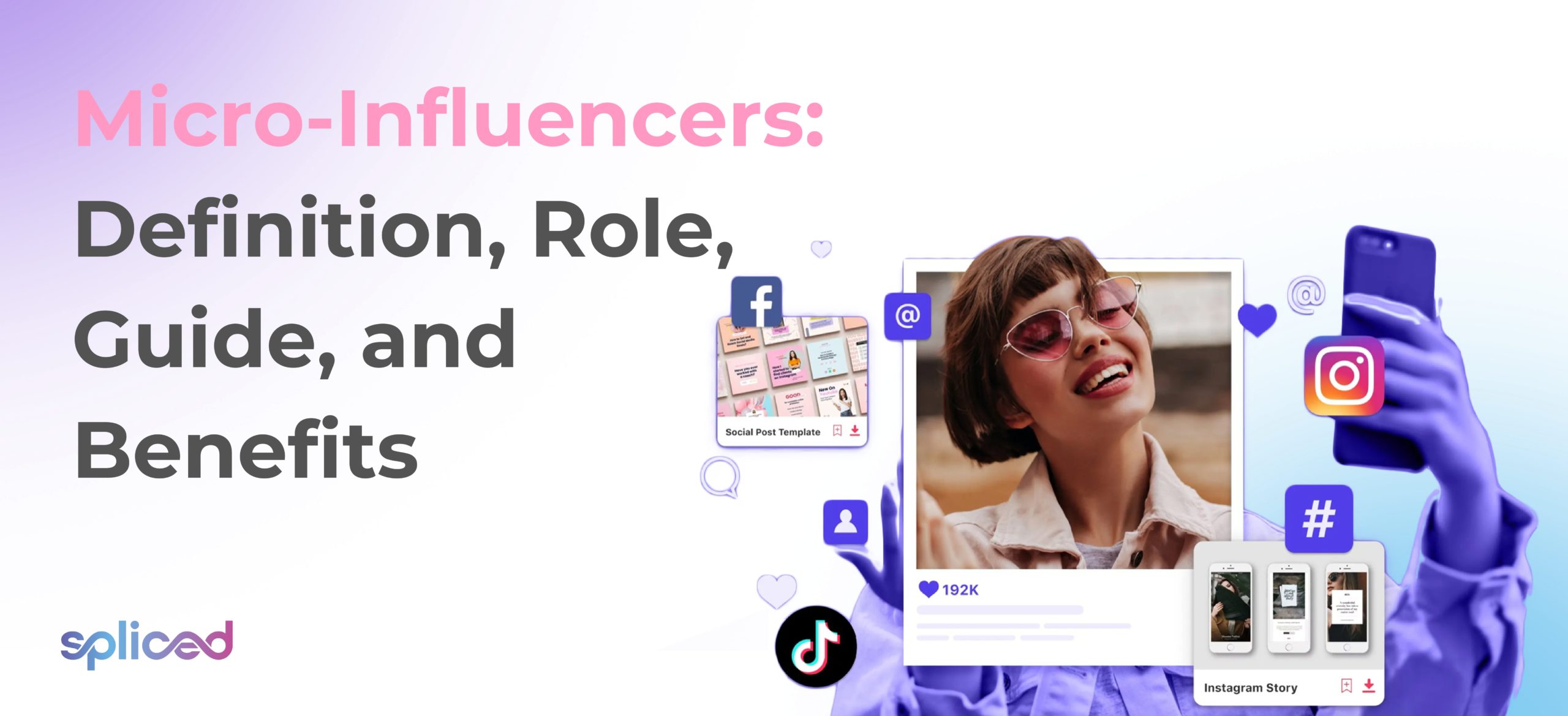The emergence of micro-influencers has changed how brands connect with their target groups in the ever-changing world of influencer marketing. Micro-influencers are people who have a small but loyal online following, which is usually between 10,000 and 50,000 people. Micro-influencers are not as big as macro-influencers or as famous as celebrities. Micro-influencers focus on specific niches and provide authentic, relatable content that really hits home with their involved communities. The new way of doing things has made for digital marketing to be more targeted and effective, with micro-influencers acting as bridges between brands and niche groups.
Micro-influencers are content makers and opinion leaders who have built up a loyal and engaged following on social media platforms or other online channels. The influence is strong in a certain niche or business, which lets them give their followers deep insights and real recommendations. These people are known for being able to make important connections within their community. It gives them a level of relatability and authenticity that makes their audience feel connected to them.
Micro-influencers use their knowledge and interest in their chosen niche to make material that fits the interests of their audience. The content comes in many forms, such as posts, stories, movies, and so on. Brands and micro-influencers work together by making relationships that include sponsored posts, product reviews, giveaways, and other ways to promote the brand. The partnership takes advantage of the authenticity of the micro-influencers, giving brands access to a highly targeted and engaged audience that trusts the suggestions of the micro-influencers.
Micro-influencers are very significant because they build trust and credibility in their niche groups in influencer marketing. The followers pay attention to what they tell them, which leads to more engagement and more important interactions. Micro-influencers connect brands with their audiences by sharing brand messages in a way that feels personal and trustworthy. The job is especially significant when trying to reach people who are not interested in standard advertising.
Brands must think about a few things before working with micro-influencers. Find influencers whose areas of expertise are closely related to the brand’s business or products. Check their engagement rates, the quality of their material, and the demographics of their audience to make sure they are a good fit. Set up clear communication and rules for content creation, including how to talk about the company and how to say when something is sponsored. Talk about the terms of payment, which include money, goods, or services. Make sure to follow the law by taking care of standards for disclosure and intellectual property rights.
There are many reasons to work with micro-influencers. The high rates of engagement, authenticity, niche knowledge, and low cost make them great partners for reaching specific audiences. Micro-influencers give their followers personalized material that really speaks to them, which builds trust and credibility. There are problems, such as a smaller audience compared to bigger influencers, different quality material, and the need to manage multiple partnerships. Weigh these things against the campaign’s goals and resources to make a good choice.
Micro-influencers have changed the way influencer marketing works by combining authenticity, relatability, and focused reach in a way that no other influencer does. The fact that they help brands connect with niche groups in a meaningful way shows how important they are in modern digital marketing strategies.
What is a Micro-Influencer?
A person who has developed a small but devoted and active online following within a particular niche or issue is known as a micro-influencer. A micro-influencer often has between 1,000 and 100,000 followers on social media sites, such as Instagram, Twitter, YouTube, and TikTok, which is a modest audience compared to macro or celebrity influencers.
Micro-influencers stand out for their capacity to forge genuine and deep connections with their audience due to their narrow focus. They are perceived as more relatable and trustworthy, as they keep a tighter and more intimate relationship with their followers than larger influencers do. The contacts, responses, and the idea that they offer more sincere views and suggestions all contribute to the closer bond.
Micro-influencers concentrate on specialized niches including parenting, gaming, fashion, travel, beauty, fitness, and other areas of interest. The ability to target a specific audience who has a real interest in their material thanks to their unique emphasis leads to increased engagement rates, including likes, comments, and shares.
Micro-influencers frequently have a bigger impact inside their specialty communities because of their more narrowly focused reach. Brands and businesses are becoming more and more aware of the advantages of working with micro-influencers for niche marketing campaigns. The capacity to provide specialized and individualized information to a highly engaged audience results in more genuine product recommendations and endorsements, improving conversion rates and enhancing brand trust.
A micro-influencer is a content producer with a modest but devoted fan base who is renowned for their genuine engagement within a certain niche or issue. They are valuable because they build true relationships with their audience and provide them with real information, which makes them a good choice for brands looking to target niche audiences more authentically.

How do Micro-Influencers work?
Micro-influencers work by utilizing their sincerity and specific knowledge to build strong relationships with their attentive audience. They develop specialized content with a niche-focused strategy that connects with people that genuinely care about their chosen topic. The information is found in different formats, including posts, videos, and reviews. They create a sense of community by establishing rapport and relatability through actively participating in debates and replying to remarks.
Brands cooperate with micro-influencers to market their goods and services because they understand the importance of these engaged audiences. Sponsored content is frequently subtly included in the influencer’s normal posts and is always transparently declared in the partnership. Micro-influencers engage in affiliate marketing, plan events, or run contests to increase interaction and draw in new followers. Micro-influencers successfully bridge the gap between focused marketing and real audience connections by regularly providing legitimate recommendations, developing relationships with brands, and keeping their particular focus.

How many followers Micro-Influencers have?
Micro-influencers often have between 1,000 and 100,000 followers across a variety of social media sites, including Instagram, Twitter, YouTube, TikTok, and others. The follower range is merely a general reference as the precise number changes depending on the platform, the industry they work in, and the amount of involvement they keep with their audience. The focus of micro-influencers is on the quality of engagement and authenticity inside their specialty, instead of having a large following, such as macro or celebrity influencers.
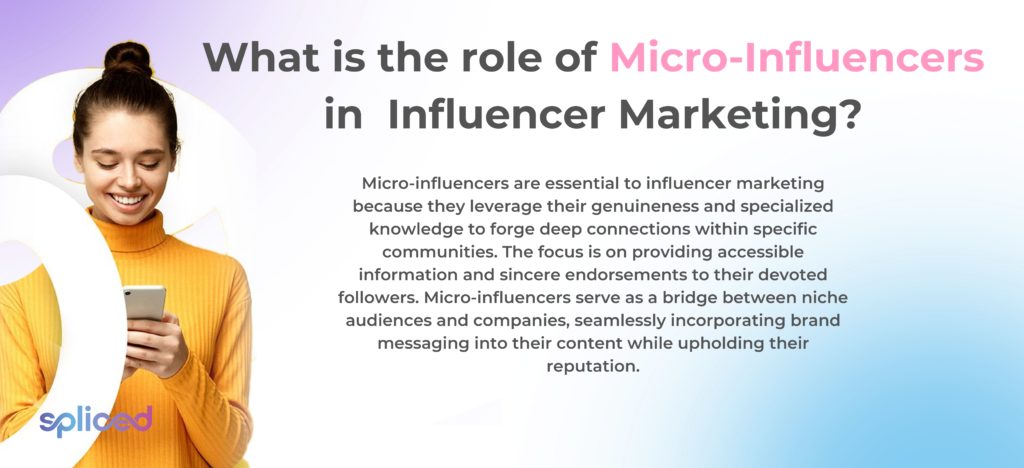
What is the role of Micro-Influencers in Influencer Marketing?
Micro-influencers are essential to influencer marketing because they leverage their genuineness and specialized knowledge to forge deep connections within specific communities. The focus is on providing accessible information and sincere endorsements to their devoted followers. Micro-influencers serve as a bridge between niche audiences and companies, seamlessly incorporating brand messaging into their content while upholding their reputation.
The capacity to add authenticity, engagement, and focused reach to influencer initiatives serves as a reminder of how significant they are. Micro-influencers build trust with their audience due to their lower follower counts and better levels of authenticity, which leads to more powerful endorsements. The engagement rates frequently outperform those of more powerful influencers, encouraging genuine exchanges and dialogue.
Brands accurately target their desired client segments because of the interaction and their specific competence. Additionally, working with micro-influencers is frequently affordable, making them a sensible option for organizations with tight budgets. They are generating devoted followings that respect their insights thanks to their specialized knowledge and community-building initiatives.
Micro-influencers add a variety of perspectives, ties to the community, and trustworthy recommendations to influencer marketing, enhancing campaigns with authenticity and establishing connections between businesses and target, responsive audiences. Micro-influencers play a crucial role within the realm of influencer marketing. They are individuals who have a relatively smaller but highly engaged and loyal follower base on social media or other online platforms.

Why do businesses work with Micro-Influencers?
Businesses use micro-influencers because they significantly improve their marketing efforts for a number of convincing reasons. The main reasons why businesses deal with micro-influencers are their authenticity, focused audience, and affordability. Micro-influencers provide a more genuine and personal relationship with their active followers, making endorsements seem more real and reliable.
Businesses accurately target their ideal consumer segments thanks to their specialized niche audiences, which raises the connection with receptive audiences. Additionally, working with micro-influencers is frequently on a tight budget, making them a sensible choice for businesses trying to maximize their marketing impact without making a big financial commitment.
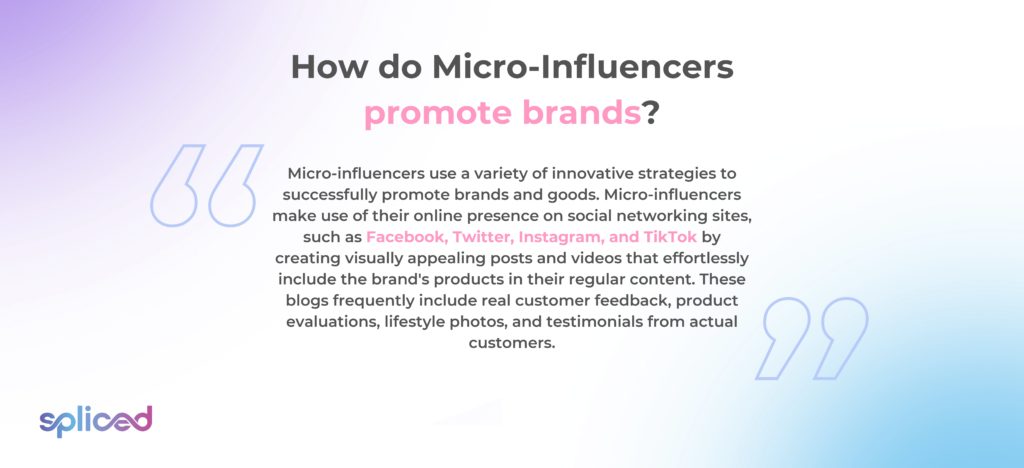
How do Micro-Influencers promote brands?
Micro-influencers use a variety of innovative strategies to successfully promote brands and goods. Micro-influencers make use of their online presence on social networking sites, such asFacebook, Twitter, Instagram, and TikTok by creating visually appealing posts and videos that effortlessly include the brand’s products in their regular content. These blogs frequently include real customer feedback, product evaluations, lifestyle photos, and testimonials from actual customers.
Micro-influencers’ video content has become a potent tool for micro-influencers to interact with their audience. They produce a variety of video content using platforms, such as YouTube and TikTok, including tutorials, unboxing videos, vlogs, and challenge videos that highlight the brand in interesting and entertaining ways.
Micro-influencers have personal blogs or websites where they offer in-depth critiques, essays, and posts centered on the businesses they work with. The written content efficiently conveys a deeper grasp of the brand’s offerings through extensive insights, individualized tales, and in-depth assessments. Micro-influencers expertly bring companies to their engaged audiences using these techniques, social media engagement, video content, and intelligently written pieces, while customizing their approach to the tastes of their specialized group.
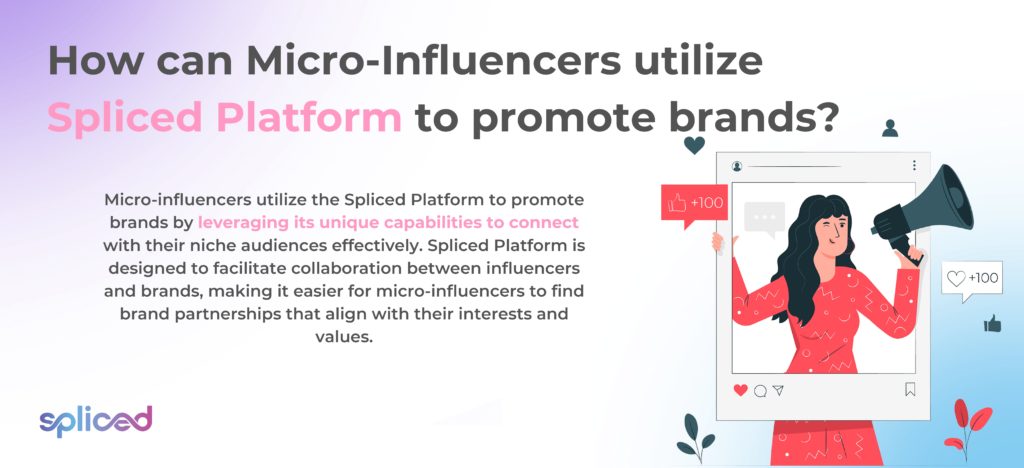
How can Micro-Influencers utilize Spliced Platform to promote brands?
Micro-influencers utilize the Spliced Platform to promote brands by leveraging its unique capabilities to connect with their niche audiences effectively. Spliced Platform is designed to facilitate collaboration between influencers and brands, making it easier for micro-influencers to find brand partnerships that align with their interests and values. Micro-influencers discover brands looking for authentic and personalized marketing campaigns through the platform, which is essential for maintaining their credibility with their dedicated follower base. Spliced Platform provides tools and resources for content creation, allowing micro-influencers to produce high-quality, engaging content that resonates with their audience and effectively showcases the brand’s products or services. Micro-influencers enhance their reach, engagement, and impact, creating a win-win situation for the influencer and the brands they collaborate with by harnessing the power of the Spliced Platform.
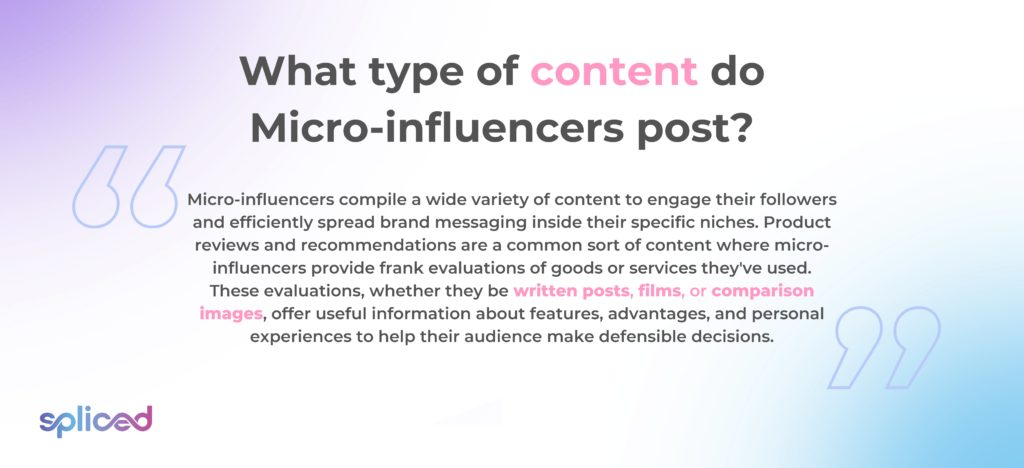
What type of content do Micro-influencers post?
Micro-influencers compile a wide variety of content to engage their followers and efficiently spread brand messaging inside their specific niches. Product reviews and recommendations are a common sort of content where micro-influencers provide frank evaluations of goods or services they’ve used. These evaluations, whether they be written posts, films, or comparison images, offer useful information about features, advantages, and personal experiences to help their audience make defensible decisions.
Tutorials and how-to guides are another important type of content, where micro-influencers demonstrate their knowledge by giving detailed instructions. These tutorials cover a wide range of topics, including DIY tasks, workout routines, cooking techniques, and more. They provide their devoted followers with useful insights and suggestions that they put to use.
Micro-influencers establish a personal connection by disclosing personal anecdotes and behind-the-scenes looks into their daily life. The method fosters authenticity and relatability by sharing insights into their creative process, travel experiences, difficulties, and key life events. Micro-influencers connect their audience while efficiently delivering brand messages catered to the interests and needs of their specific community by creating a blend of educational, relatable, and visually appealing material.
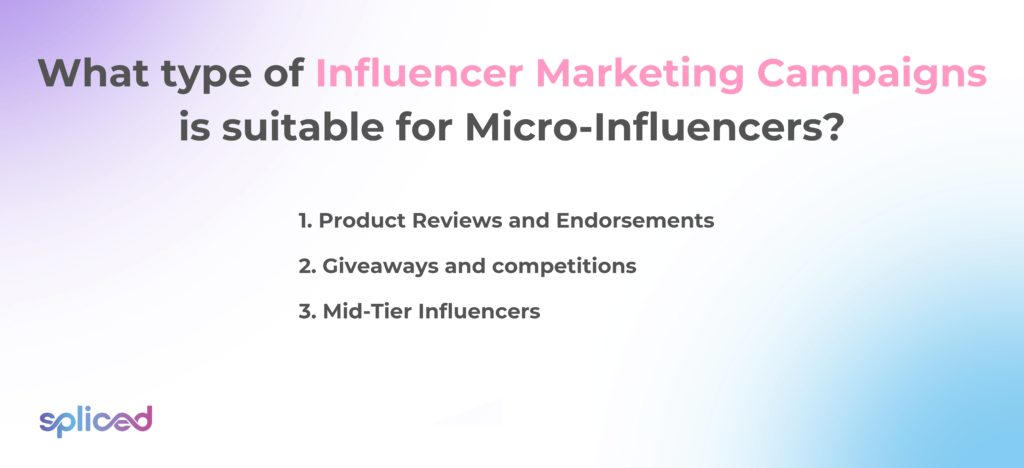
What type of Influencer Marketing Campaigns is suitable for Micro-Influencers?
Listed below are the types of Influencer Marketing Campaigns suitable for Micro-Influencers.
- Product Reviews and Endorsements: Micro-influencers are a good choice for campaigns involving product reviews and endorsements. Micro-influencers are given access to a brand’s goods or services in exchange for thorough and sincere reviews. These kinds of advertising make use of the authority and knowledge that micro-influencers have in their particular fields, allowing them to offer their engaged followers sincere advice. The strategy works especially well when promoting goods associated with the micro-influencers specialty because it easily fits in with their existing material.
- Giveaways and competitions: Micro-influencers work with marketers to create giveaways and competitions that boost audience engagement. Micro-influencers grow the number of their followers, raise the profile of their brands, and thrill their community by arranging these events. A type of influencer marketing campaigns gives companies the chance to highlight their goods and services while utilizing the micro-influencers capacity to build sincere relationships with their audience.
- Affiliate Marketing and Promo Codes: Micro-influencers with active fan bases are a good fit for affiliate marketing initiatives, in which they share special affiliate links or promo codes. The micro-influencers get paid when their followers make purchases using these links or coupons. These kinds of campaigns are successful when micro-influencers advocate goods or services that appeal to their target demographic. It not only promotes conversions but makes use of the credibility and trust that micro-influencers have built up among their audience.
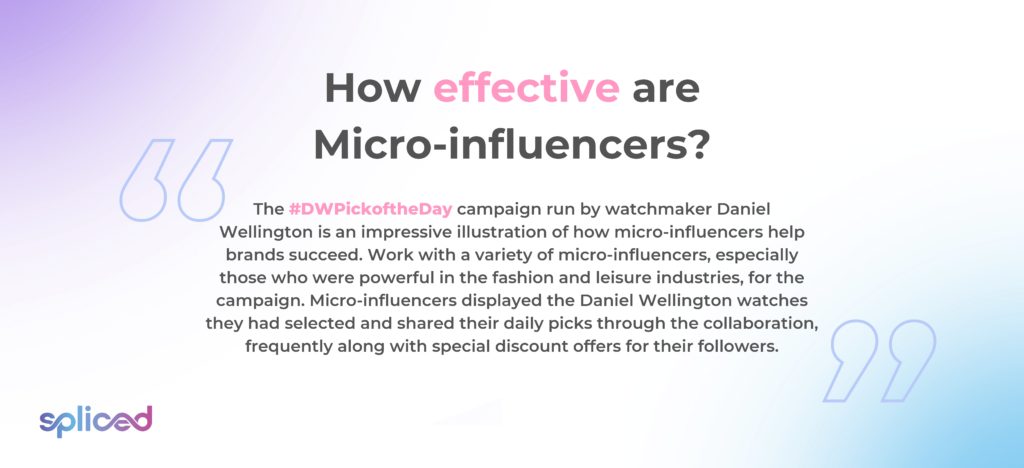
How effective are Micro-influencers?
The #DWPickoftheDay campaign run by watchmaker Daniel Wellington is an impressive illustration of how micro-influencers help brands succeed. Work with a variety of micro-influencers, especially those who were powerful in the fashion and leisure industries, for the campaign. Micro-influencers displayed the Daniel Wellington watches they had selected and shared their daily picks through the collaboration, frequently along with special discount offers for their followers.
The campaign’s outcomes were outstanding and demonstrated the power of working with micro-influencers. The frequent and customized posts from micro-influencers helped the brand’s awareness rise inside the fashion and accessories sector. These influencers had with their audience, the campaign successfully increased engagement, resulting in a greater rate of likes, comments, and shares because of the genuine connections. The increased interest resulted in more people visiting Daniel Wellington’s website, as the visually appealing material and enticement of discount codes encouraged customers to learn more about the company’s products. The campaign had a favorable effect on sales, with an increase in purchases of the highlighted watch models, confirming the power of micro-influencers in influencing customer behavior.
The Daniel Wellington campaign is a potent example of how micro-influencers persuasively convey brand messaging, establish connections with their audience, and positively affect different stages of the marketing journey, from increased brand awareness to increased sales figures. Brands utilize a potent weapon to produce tangible outcomes in line with their strategic objectives through the genuine rapport and engagement that micro-influencers bring to the table.
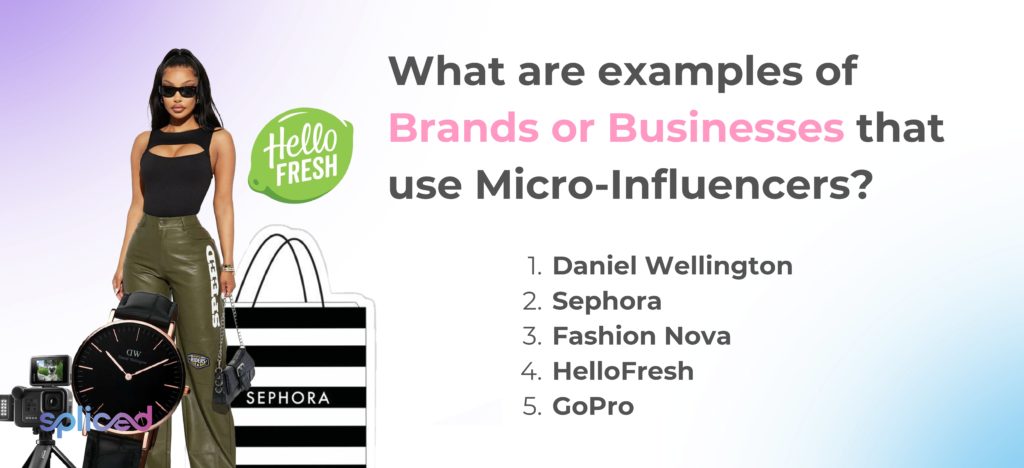
What are examples of Brands or Businesses that use Micro-Influencers
Listed below are examples of Brands or Businesses that use Micro-Influencers.
- Daniel Wellington: Daniel Wellington is a watch brand that made the #DWPickoftheDay campaign with the help of micro-influencers. Micro-influencers told their followers about their best Daniel Wellington watches and gave them discount codes. Micro-influencers made the brand more visible, got people interested, drove more people to the website, and made more sales.
- Sephora: Sephora often works with “micro-influencers” in the beauty industry to show off their goods through makeup tutorials, reviews, and demos. These influencers give their fans honest advice that resonates with them, which boosts the brand’s credibility and sales.
- Fashion Nova: Fashion Nova is a clothing brand that works with fashion micro-influencers who use picture posts and lookbooks to show off their clothes. Micro-influencers help the brand get in on the latest fashion trends and connect with a younger audience.
- HelloFresh: HelloFresh is a service that sends meal kits. HelloFresh works with food and cooking “micro-influencers” to make lessons for their meal kits and show how they are used. These partnerships show how convenient and good HelloFresh’s items are.
- GoPro: GoPro works with adventure and trip micro-influencers to show off what their action cameras do. Micro-influencers use GoPro cameras to record exciting times and experiences, showing how versatile the brand is.
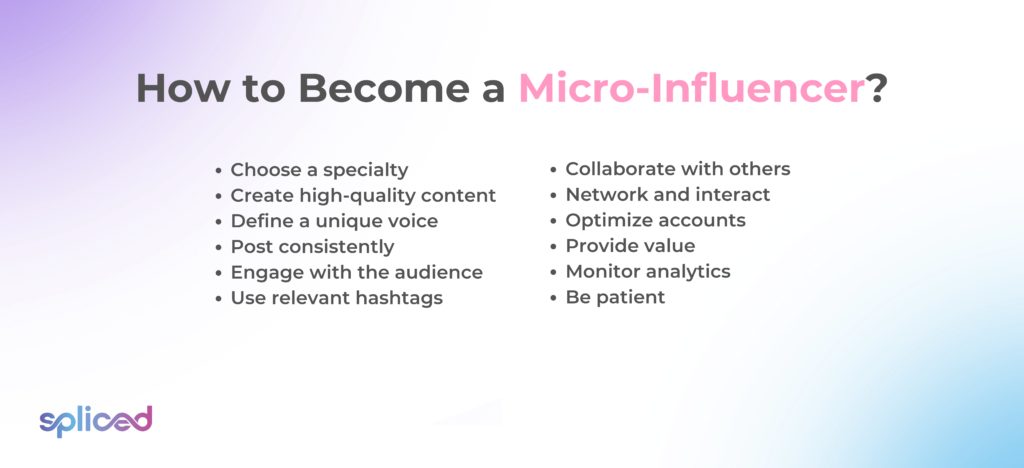
How to Become a Micro-Influencer?
Listed below are the steps to becoming a Micro-Influencer.
- Pick a Specialty: Choose a specific area or topic that you are really interested in and know a lot about. Choosing a topic helps to find people who are interested in the same things one is.
- Create High-Quality Content: Make content that is visually appealing, full of useful information, and fits with the area selected. Make sure that the material, whether it is photos, videos, blog posts, or something else, is useful to the people who follow.
- Define the Unique Voice: Give the writing its own style and attitude. The genuine style sets apart and draws people who like the way to do things.
- Make consistent posting: Post often and in the same way to keep the audience interested and get more fans. Having a regular posting plan helps people notice and gets them excited.
- Engage with the Audience: Talk to the followers by replying to their comments, answering their questions, and taking part in conversations. Building a strong link with the audience makes it more real and keeps them coming back.
- Use Relevant Hashtags: Use relevant hashtags in the posts to help people who are interested in the field find the content. Find out what the most popular and niche-specific topics are to reach more people.
- Work with Others: Work with other micro-influencers or people who make content in the field. Cross-promotions and partnerships help to reach new people and get the name out there.
- Network and interact: Interact with other users in the niche by liking, writing on, and sharing their content. Making connections with fans and peers help to get known and build relationships.
- Optimize accounts: Make sure that the bios, profile pictures, and branding are clear and consistent across all the social media accounts. Help people understand the field and what it has to offer.
- Give something of value: Share helpful ideas, tips, suggestions, and entertaining content that is linked to the niche. It makes it look like an expert and keeps the fans interested.
- Monitor Analytics: Pay attention to how the content is doing by using the analytics tools that social media sites offer. Follow things, such as engagement rates, reach, and the number of new followers to improve the approach.
- Be patient: It takes time to build a real and active following. Be patient, stay focused on the niche, and keep giving the fans value.
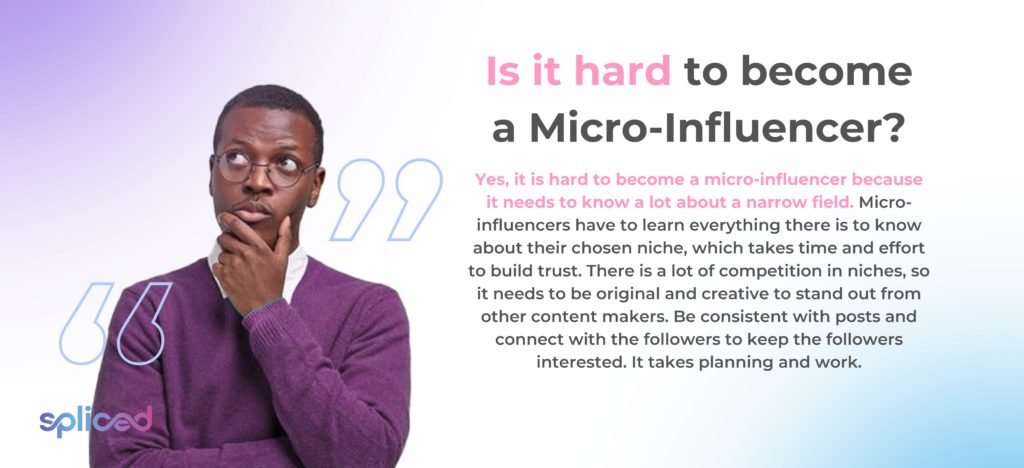
Is it hard to become a Micro-Influencer?
Yes, it is hard to become a micro-influencer because it needs to know a lot about a narrow field. Micro-influencers have to learn everything there is to know about their chosen niche, which takes time and effort to build trust. There is a lot of competition in niches, so it needs to be original and creative to stand out from other content makers. Be consistent with posts and connect with the followers to keep the followers interested. It takes planning and work.
Using involvement to build real relationships takes time and a long-term commitment. It is possible to become a micro-influencer with the right plan. Build a real relationship with a specific audience that shares interests by specializing in a niche. It makes it easier for people to get involved and stay loyal.
Authenticity is a key part of being a successful micro-influencer, and it comes easily when making content that fits with the personality and interests. Niche groups tend to be more helpful, and they help grow by appreciating the content that provides value. Micro-influencers tend to grow faster and in more concrete ways compared to bigger influencers. It is shown by higher response rates and deeper connections with followers.
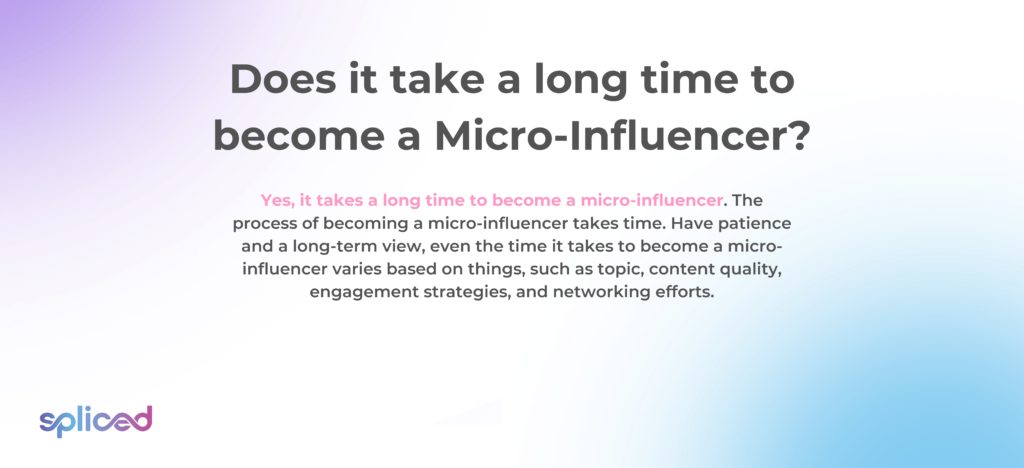
Does it take a long time to become a Micro-Influencer?
Yes, it takes a long time to become a micro-influencer. The process of becoming a micro-influencer takes time. Have patience and a long-term view, even the time it takes to become a micro-influencer varies based on things, such as topic, content quality, engagement strategies, and networking efforts.
Building a loyal and engaged following, proving authenticity, and becoming an expert in a specific field takes time and consistent effort. It is not unusual for micro-influencers to spend several months to a couple of years building their presence and building a loyal following before they become well-known and influential in their chosen niche. Micro-influencer are more likely to be successful when growing slowly, keep making content, and connect with the followers in meaningful ways.
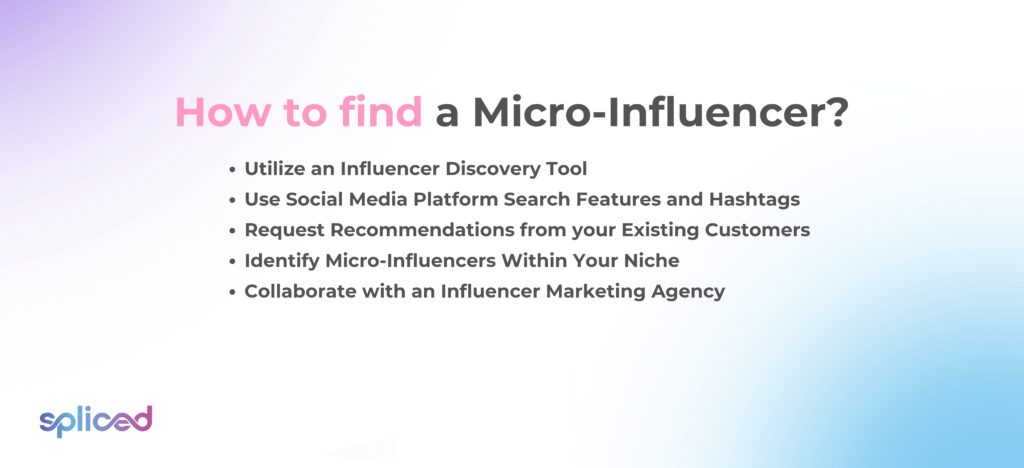
How to find a Micro-Influencer?
Listed below are the steps on how to find a micro-influencer.
- Utilize an Influencer Discovery Tool: There are numerous influencer discovery platforms available that help search for micro-influencers based on criteria, such as niche, follower count, engagement rates, and demographics. Influencer Discovery Tool streamlines the process by providing a curated list of potential collaborators.
- Use Social Media Platform Search Features and Hashtags: Use search features to find micro-influencers within the niche on platforms including Instagram, Twitter, and TikTok. Searching for relevant hashtags leads to content creators who are actively discussing topics related to the brand.
- Request Recommendations from your Existing Customers: Engaging with the current customers yield valuable insights. They are following micro-influencers who align with the brand, and their recommendations lead to potential collaboration partners.
- Identify Micro-Influencers Within Your Niche: Research the industry or niche thoroughly to identify micro-influencers who are already creating content related to the field. Look for those whose values align with the brand and whose audience matches the target demographic.
- Collaborate with an Influencer Marketing Agency: Influencer marketing agencies specialize in connecting brands with suitable influencers. They have networks and expertise to identify micro-influencers that align with the goals, making the collaboration process more streamlined and efficient.
1. Utilize an influencer discovery tool
Utilize an influencer discovery tool. An influencer discovery tool is a piece of software or an online platform that helps companies and marketers find influencers, even micro-influencers, with whom they work together. Influencer discovery tools make it easier to find influencers because they give data-driven insights and a lot of information about influencers in certain areas or industries.
Most tools for finding influencers work by letting users put in factors including niche, number of followers, engagement rate, location, and demographics. The tool then searches through different social media sites to find information about leaders who meet the set criteria. The tool’s algorithm looks at things like how engaged the audience is, how real the content is, and how good it is, to come up with a list of possible influences.
Influencer discovery tools are important because they help brands find the people who are most likely to help them reach their goals. They save time and effort that have been spent looking for the right influences by hand. These tools make sure that the influencers chosen have the right audience demographics and levels of engagement, which makes influencer marketing efforts effective.
Influencer discovery tools streamline and optimize influencer marketing campaigns by automating the process of finding suitable influencers, saving time and resources. Influencer discovery tools provide accurate data-driven insights to identify influencers whose engagement, follower count, and niche alignment match brand requirements. Marketers benefit from comprehensive insights into influencer profiles, metrics, and audience demographics, enabling informed collaboration decisions.
Niche targeting ensures that brands connect with influencers specialized in specific areas, resonating with receptive audiences. Working with well-matched influencers through these tools enhances campaign effectiveness, increasing the likelihood of achieving desired outcomes. In essence, influencer discovery tools play a pivotal role in enhancing efficiency, accuracy, and campaign success within the realm of influencer marketing.
A tool for finding influential people is “AspireIQ.” The site lets people find micro-influencers based on specific criteria using advanced search and filtering tools. AspireIQ gives information about how often leaders are engaged, who their followers are, and how good their content is. Brands quickly find micro-influencers who are a good fit for their brand identity and marketing goals by using AspireIQ. It makes sure that the partnership works out well.
2. Use social media platform search features and hashtags
Use social media platform search features and hashtags. Using built-in search tools and relevant hashtags on social media platforms, such as Instagram, Twitter, and TikTok to find micro-influencers in a specific area is called “using social media platform search features and hashtags.”
Put buzzwords that are related to the niche into the search bar of a social media site. Look at popular or niche-specific hashtags to find posts and profiles that are connected to the business. Find micro-influencers who are making material that fits the niche of the brand. Using the search tools and hashtags on social media platforms, find influencers who are actively making content for the business. It helps in finding real micro-influencers who are genuinely interested in the area.
Utilizing social media platform search features and hashtags is a proactive approach to discovering micro-influencers aligned with the brand’s niche. The method offers the advantages of direct discovery, enabling a seamless fit between influencer content and brand identity. Gain real-time insights into engagement levels and audience responses, providing a valuable measure of authenticity by exploring relevant hashtags and profiles.
The approach is particularly effective in uncovering influencers who genuinely share the niche’s passion, resulting in credible endorsements and relatable content. The ability to directly browse influencer profiles empowers one to make well-informed decisions, evaluating content quality, style, and relevance.
For example, a company that makes exercise clothes wants to work with micro-influencers in the fitness and wellness niche. The brand look for tags, such as #FitnessJourney or #HealthyLifestyle on Instagram or other social media platforms. They find micro-influencers who share workout plans, healthy recipes, and fitness tips on a daily basis by looking at posts with these hashtags. The brand then looks at the content and amount of engagement of these influencers to find good collaboration partners who are popular with their target audience.
3. Request recommendations from your existing customers
Requesting recommendations from existing customers means reaching out to people who have bought the products or services and asking them to recommend micro-influencers they follow and like who are in the same niche as the brand.
Interact with current customers by sending them polls, emails, or posts on social media. Ask them who they think are the most influential micro-influencers in the business. Buyers tell about micro-influencers who are popular with the people who want to reach them.
Current customers already know the brand and what it stands for. Their suggestions lead to micro-influencers who are popular with the same people it wants to reach and whose content fits with the business.
Requesting recommendations from current customers presents an insightful approach to discovering micro-influencers. Gain a clear understanding of influencers who genuinely resonate with the audience by tapping into their insights. The method enables a targeted approach, as micro-influencers favored by the customers are more likely to align with the brand’s values and appeal to the desired demographic.
Collaborating with micro-influencers suggested by the customers adds an authentic touch to the campaigns, leveraging their existing respect within the customer community. Involving customers in the influencer discovery process not only enhances loyalty but strengthens the sense of brand community, fostering deeper connections.
For example, a company that makes eco-friendly skin care products sends out a survey to their customers asking which skincare gurus they trust and follow. Find that their customers like leaders who focus on beauty practices that are good for the environment based on the answers they got. The brand reaches out to the proposed micro-influencers, knowing that their work together resonates with their current customers, and further promotes their brand values with this information.
4. Identify micro-influencers within your niche
Identify a micro-influencer within the niche. Research and look for content creators who have made a name for themselves as experts or fans in an industry or topic that is important to the brand to find micro-influencers in the niche. The process needs a lot of study on social media platforms and other online channels. Look for people who regularly make content related to the area, interact with their audience, and show that they really care about the topic.
Finding micro-influencers in the niche is important because it makes sure that the influencers who work with them know a lot about the industry and give credible recommendations that connect with the target audience. Identifying micro-influencers within the niche is a strategic approach that leverages their expertise to connect with a relevant audience.
Collaborating with influencers deeply immersed in the niche ensures authenticity, as their genuine passion translates into trustworthy endorsements for the brand. The established authority lends credibility, making their recommendations impactful for their followers. Influencers aligned with the niche seamlessly integrate the brand into their content, creating an organic collaboration that resonates with their audience and showcases the products or services effectively.
A fitness supplement business that wants to get the word out about its products finds micro-influencers who share workout plans, nutrition tips, and fitness challenges on a regular basis. These influencers are well-known in the fitness niche and have a strong following of people who care about health and wellness. The brand of supplements uses its knowledge and credibility to show the benefits of its goods to an audience that is interested in working with these influencers.
5. Collaborate with an influencer marketing agency
Collaborate with an influencer marketing agency. Working with an influencer marketing firm means working with a specialized company that helps brands find, connect with, and manage collaborations with influencers, including micro-influencers.
Brands tell the agency their marketing goals and criteria. The agency then uses its knowledge, resources, and network to find the right micro-influencers, discuss terms, set up partnerships, and track how well the campaign is doing.
Working with an influencer marketing firm speeds up the process of finding and managing influencers. It lets brands take advantage of their industry knowledge and focus on other parts of their marketing strategy.
Collaborating with an influencer marketing agency streamlines the influencer partnership process, offering a range of advantages. Agencies ensure connections with the most suitable micro-influencers for the brand with industry expertise and insights. They handle time-consuming tasks including influencer search, outreach, and negotiations, optimizing the resource allocation.
Agencies contribute to campaign strategy development that aligns with the brand’s objectives and values. They maintain influencer relationships, ensuring seamless collaborations and sustained partnerships. Agencies provide valuable data and analytics to measure the performance and impact of influencer campaigns, facilitating informed decision-making and campaign optimization.
A fashion store that wants to start a campaign with micro-influencers works with an influencer marketing firm. The agency is in charge of finding fashion “micro-influencers” whose style matches the brand’s. They are in charge of communication, rules for making material, and campaign monitoring. The agency’s expertise helps the retailer, which ends up with a successful campaign that touches the right people and gets the results they want.
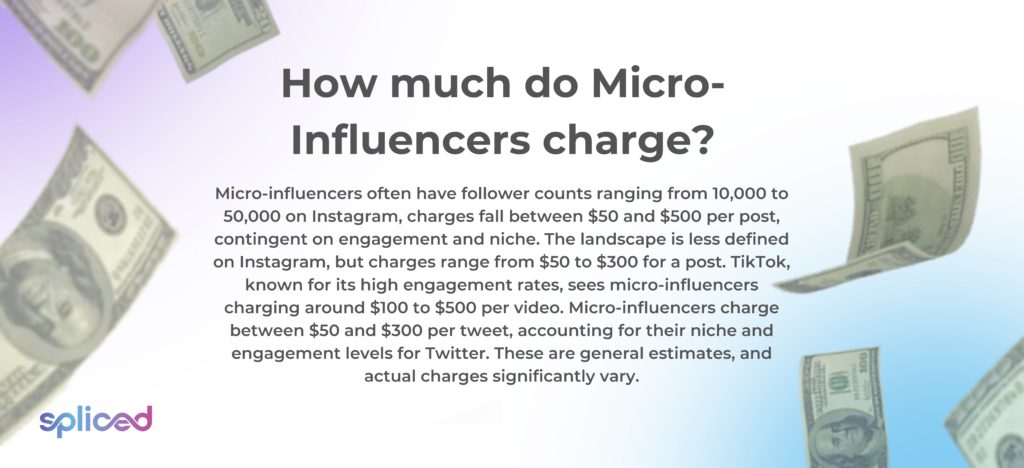
How much do Micro-Influencers charge?
Micro-influencers often have follower counts ranging from 10,000 to 50,000 on Instagram, charges fall between $50 and $500 per post, contingent on engagement and niche. The landscape is less defined on Instagram, but charges range from $50 to $300 for a post. TikTok, known for its high engagement rates, sees micro-influencers charging around $100 to $500 per video. Micro-influencers charge between $50 and $300 per tweet, accounting for their niche and engagement levels for Twitter. These are general estimates, and actual charges significantly vary. The fees that micro-influencers charge vary widely across different social media platforms, influenced by factors, such as follower count, engagement rate, niche, and content quality. Micro-influencers typically charge different rates for various platforms.
Micro-influencers’ income fluctuates based on the number of collaborations secured, their charging rates, and content consistency. Monthly earnings span from a few hundred dollars to several thousand dollars. Micro-influencers explore alternative income streams, such as affiliate marketing, sponsored content, merchandise sales, and niche-related consulting services. Note that influencer marketing dynamics evolve, and the most accurate rates are obtained by researching current industry trends and practices.
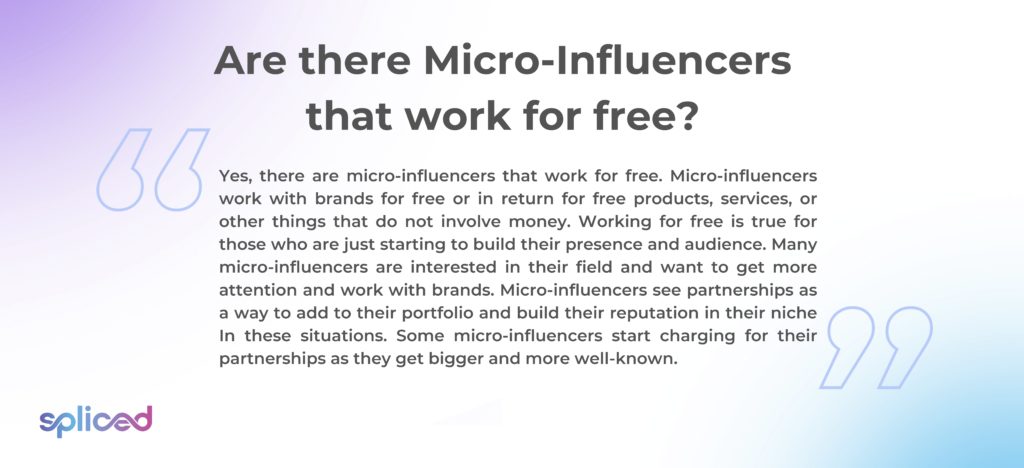
Are there Micro-Influencers that work for free?
Yes, there are micro-influencers that work for free. Micro-influencers work with brands for free or in return for free products, services, or other things that do not involve money. Working for free is true for those who are just starting to build their presence and audience. Many micro-influencers are interested in their field and want to get more attention and work with brands. Micro-influencers see partnerships as a way to add to their portfolio and build their reputation in their niche In these situations. Some micro-influencers start charging for their partnerships as they get bigger and more well-known.
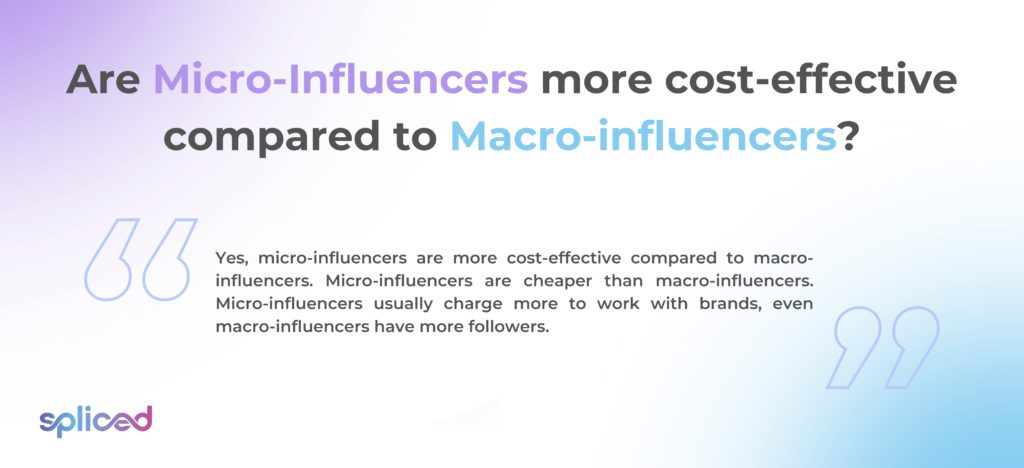
Are Micro-Influencers more cost-effective compared to Macro-influencers?
Yes, micro-influencers are more cost-effective compared to macro-influencers. Micro-influencers are cheaper than macro-influencers. Micro-influencers usually charge more to work with brands, even macro-influencers have more followers.
Micro-influencers tend to have a smaller number of followers, but they have better engagement rates and reach more targeted audiences. The fees are lower than macro-influencers, which makes them a better choice for brands that want to reach a specific group without spending a lot of money. The endorsements have a bigger effect and are more genuine, making them a better investment because micro-influencers are more real and have closer relationships with their followers.
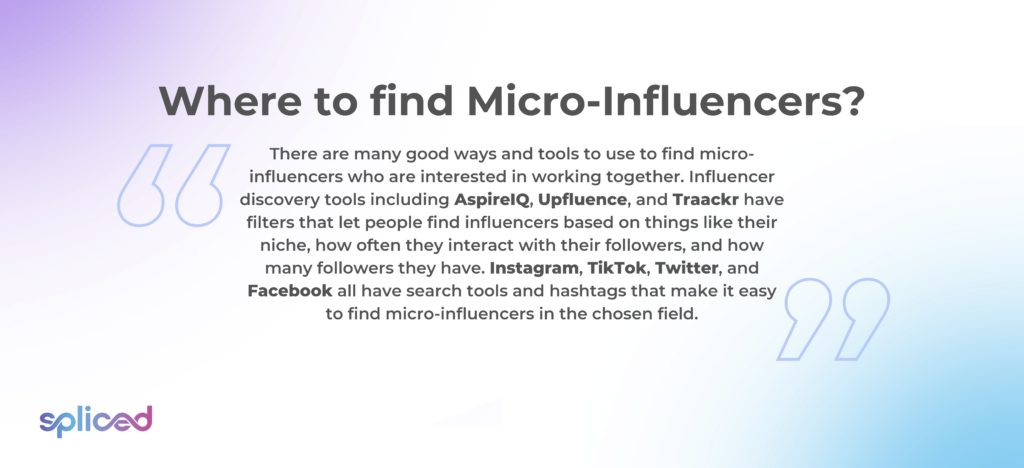
Where to find Micro-Influencers?
There are many good ways and tools to use to find micro-influencers who are interested in working together. Influencer discovery tools including AspireIQ, Upfluence, and Traackr have filters that let people find influencers based on things like their niche, how often they interact with their followers, and how many followers they have. Instagram, TikTok, Twitter, and Facebook all have search tools and hashtags that make it easy to find micro-influencers in the chosen field.
Find content creators who are micro-influencers by participating in online forums, Facebook groups, and Reddit communities that are connected to the industry. Going to industry events and conferences gives a chance to meet people who are micro-influencers in the area. Ask the current customers for suggestions of micro-influencers, and look at the rivals to see who they have partnered with. Research hashtags, hire influencer marketing companies, or find bloggers and content creators through guest posts or collaborations. Look at engagement rates, material quality, authenticity, and how well it fits with the brand’s values, even the number of followers is important.
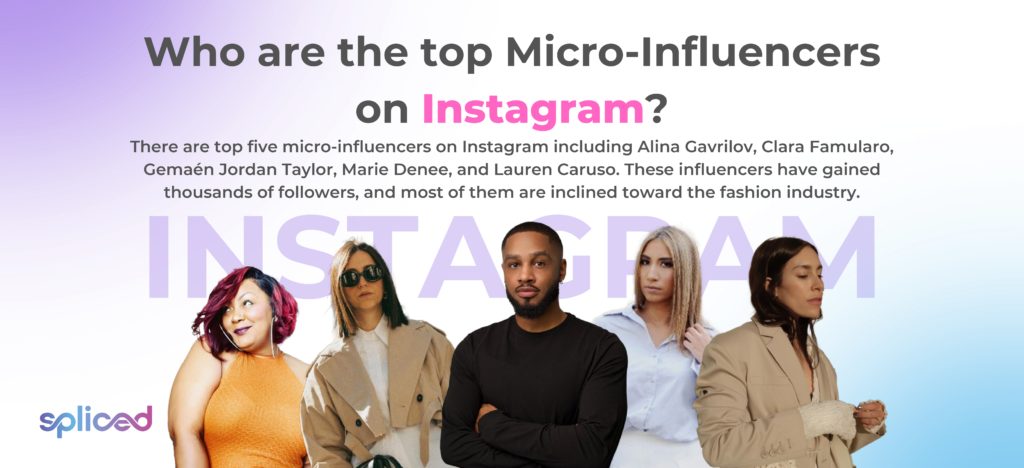
Who are the top Micro-Influencers on Instagram?
There are top five micro-influencers on Instagram including Alina Gavrilov, Clara Famularo, Gemaén Jordan Taylor, Marie Denee, and Lauren Caruso. These influencers have gained thousands of followers, and most of them are inclined toward the fashion industry.
Alina Gavrilov username on Instagram is @alinagavrilov with 99.2K followers. Alina Gavrilov is one of the Top Micro-Influencers on Instagram and used to be a lawyer in New York, but now blogs about fashion. Alina calls herself the “Blazer Queen,” and she shows off her everyday classic and girly style and her 9-to-5 clothes so that young working women get ideas from her. She thinks that the best way to get an everyday look for work or play is to keep it simple and use it in different ways.
Clara Famularo’s username on Instagram is @clarafamularo with 99.5K followers. Clara Famularo is a stylist who lives in Sydney. Clara became famous when she was named one of the Top Micro-Influencers in the fashion niche. Clara started two businesses that were close to her heart as someone who loves fashion and shoes. Clara’s two businesses are named as Milan the Label, an online clothing shop, and Sydney Uggs, a company that sells shoes. The Instagram account of Clara Famularo is full of OOTDs and styling tips using her brand, and paid posts for personal care brands includingTanzee, Hair and Beauty Angel, and Daily Naturals. It makes Clara one of the top micro-influencers on Instagram in 2022.
Gemaén Jordan Taylor username on Instagram is @gamaentaylor with 66.2K followers. Gemaén Jordan Taylor is a South African model, TV show host and presenter, writer, and one of the top micro-influencers who loves luxury wear and unique styles. Gemaén was chosen as South Africa’s GQ Best Dressed Man for 2019 because Gemaén is handsome and has great style. Fashion brands, such as SunglassHut South Africa, 4th Street Wine, H&M, Elemis, and Consol glass, have sponsored or partnered with Gemaén because there are a lot of likes and comments on Gemaén Instagram.
Marie Denee’s username on Instagram is @mariedenee with 60.5K followers. Marie Denee, known as M.D., is a curvy influencer who is making moves in the fashion world. The Curvy Fashionista is a writer based in Atlanta, Georgia. Marie Denee is an expert on plus-size fashion and style and one of the top micro-influencers on Instagram in 2022. Marie uses Instagram and blogs to talk about, teach about, and praise the unique beauty of plus-size women as a supporter of positive body image and self-confidence. Marie has written about plus-size fashion trends and advice for a number of magazines and websites, including Vogue Curvy, Signature 9, Examiner.com for Plus size fashion, Seventeen Magazine, and many more.
Lauren Caruso’s username on Instagram is @laurencaruso with 53.4K followers. Lauren Caruso is a well-known micro-influencer in the fashion world. Lauren Caruso is a freelance writer, creative adviser, and digital media strategist based in New York. Lauren has been in the writing business for more than ten years, and regularly writes about fashion for Harper’s Bazaar, Allure, Byrdie, Coveteur, CNN Underscored, and Verizon’s In The Know. Her growing number of Instagram fans has allowed her to work with high-end brands includingBurberry, Levi’s, COS, Farfetch, La Mer, Club Monaco, Shopbop, and Marc Jacobs, making it one of the top micro-influencers on Instagram in 2022.
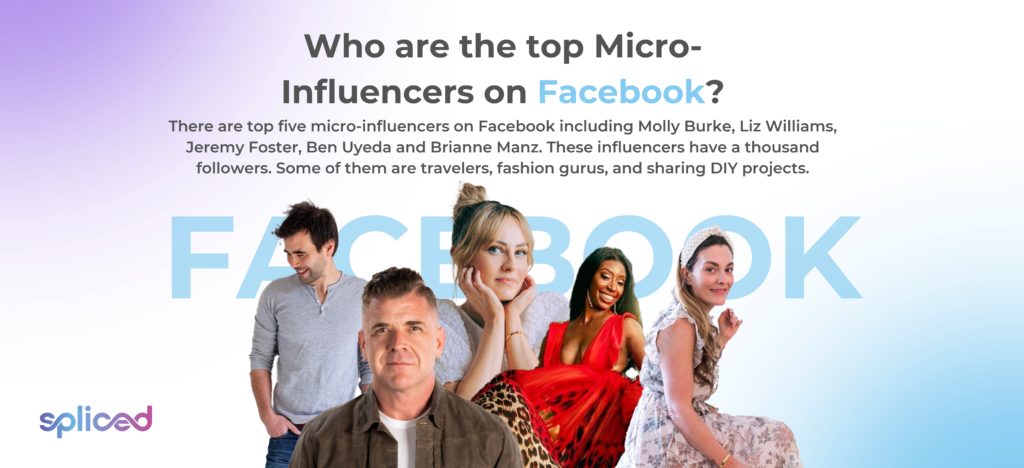
Who are the top Micro-Influencers on Facebook?
There are top five micro-influencers on Facebook including Molly Burke, Liz Williams, Jeremy Foster, Ben Uyeda and Brianne Manz. These influencers have a thousand followers. Some of them are travelers, fashion gurus, and sharing DIY projects.
Molly Burke is an author, a model, and an inspiring speaker. Molly has 43,000 fans and is one of the Top Micro-influencers on Facebook. Burke is blind. Molly Burke’s eye disease, retinitis pigmentosa, caused Molly to lose sight when Molly was four years old. Burke’s Facebook page has pictures and videos from places Molly’s been and things Molly’s done, like when she went figure skating with Olympic skater Adam Ripon. Burke has been the face of Dove’s ad campaign and has worked with the United Nations Foundation and companies, such asSamsung and Audible. People, Allure, Variety, The New York Times, and The Washington Post have all written about Molly.
Liz Williams is a beauty and fashion micro-influencer from the U.K. who goes by the name LizLizLive on social media. Liz has almost 28,000 Facebook fans. Williams writes about makeup, hair, fashion, exercise, and reviews of products. A lot of what she writes is for women of color.
Jeremy Foster is a full-time travel blogger and photographer who lives in Washington, D.C. Jeremy has 18,000 Facebook fans. Foster is known as a “Travel Freak” on social media and on blogs. Jeremy shares pictures and videos of Jeremy’s travels, which have taken Jeremy to places including Oahu and Munich. Foster has been written about in National Geographic, Vanity Fair, and the New York Times, among other places. Jeremy’s website has reviews of travel goods, articles about places to visit, and tips for traveling.
People who follow Ben Uyeda are the kind who want to learn how to make things like bent plywood lounge chairs or pizza ovens in the shape of skulls. Uyeda, who lives in Boston, shows the 16,000 Facebook fans how to do just that. Uyeda’s company, HomeMade Modern, comes up with DIY plans for modern furniture that is strong, cheap, and made from eco-friendly materials. Ben’s a supporter of cheap design, and working with MINI to get the word out about the first all-electric MINI.
Mommy blogger Brianne Manz has close to 15,000 Facebook fans who like her family-focused posts about New York City. Posts talk about things like when the family went to see the newly remodeled Empire State Building and how Brianne stays in shape despite having a busy schedule. Manz has worked with sponsored content on brands, such as the real estate business Prevu. Manz used to own a fashion store, and now writes about fashion and travel on a blog.
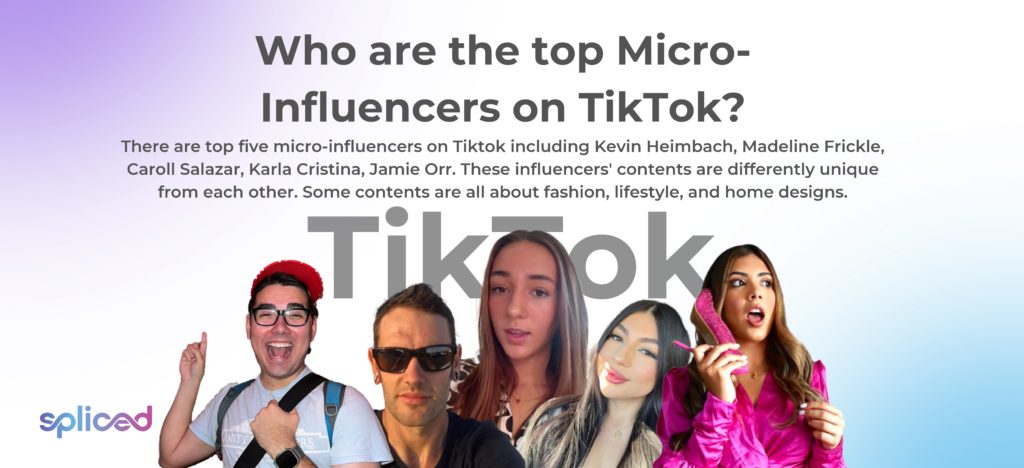
Who are the top Micro-Influencers in TikTok?
There are top five micro-influencers on Tiktok including Kevin Heimbach, Madeline Frickle, Caroll Salazar, Karla Cristina, Jamie Orr. These influencers’ contents are differently unique from each other. Some contents are all about fashion, lifestyle, and home designs.
Kevin Heimbach is one of the Top Micro-influencer on TikTok and love’s theme parks. Kevin’s 40,000 YouTube followers know it because Kevin reviews and recaps everything from Universal Studios to Busch Gardens. Kevin writes about interesting rides, foods, and festivals, such as Wurstfest, which is the biggest German festival in the world.
Madeline Frickle, a TikToker from Texas, talks about small parts of life as a college student. Madeline’s 34.6K followers get to see what she likes to eat, drink, wear, and use on a normal day. Frickle talks about where Madeline shops, what Madeline does to look good, and what Madeline does for fun.
Caroll Salazar is known as “MakeupHuney” by her 32.2K Instagram fans, but Caroll does not just post beauty tutorials and Caroll’s favorite products. Caroll writes about fashion, being a mom, being married, and going on trips.
Karla Cristina is a fashion and lifestyle blogger with 27.6K TikTok fans who love to see her try-on hauls, skin-care product reviews, and beauty tutorials. Karla talks about beauty tips, modeling shoots behind the scenes, and the best parts of her shopping trips.
Jamie Orr manages the dear HoME Pinterest page for Jamie’s family, which is full of people who love design and projects. More than 13,2K people come to get ideas, tips, and even recipes for things like sourdough starters. There is a lot for DIYers to get excited about, from having parties outside to updating the bathroom.
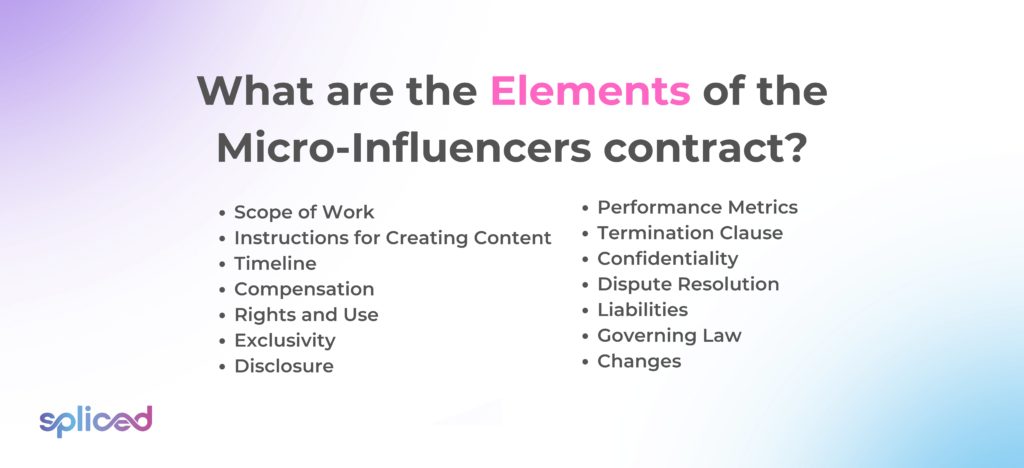
What are the elements of the Micro-Influencers contract?
Listed below are the elements of the Micro-influencers contract.
- Scope of Work: Clearly specify the influencer’s tasks, such as the number of posts, the type of content, photos, videos, and stories, and the platforms including Instagram, and TikTok that they use.
- Instructions for Creating Content: Give the influencer clear instructions for the material they make. Materials include a brand message, hashtags, mentions, visual style, and any legal requirements like mentioning sponsored content.
- Timeline: Give a timeline for creating, reviewing, and posting material. A timeline ensures everyone agrees on when things go live and if any review time is needed.
- Compensation: Be clear about how much money the influencer gets. Compensation is done with money, goods, skills, or a mix of the three. Include the terms, means, and due dates for payments.
- Rights and Use: Explain what each party is allowed to do with the material created. The brand has the right to use the influencer’s content for marketing, and the influencer has the right to share the content on their own channels.
- Exclusivity: Say if the influencer works with competitors or similar brands during and after the promotion.
- Disclosure: Include a clause that makes sure the influencer reveals their relationship with the brand in a way that follows the law, such as by using the hashtags #ad or #sponsored.
- Performance Metrics: Define the key performance indicators (KPIs) that are used to measure how well the effort is doing. Include things, such as impact, engagement, clicks, and conversions.
- Termination Clause: Write out the conditions under which either side ends the agreement early. Terminations are done because the deal was not followed, or because something unexpected happened.
- Confidentiality: Include a clause that says both parties do not share private information they have learned while working together.
- Putting an end to fights: Say how disagreements are settled, whether through mediation, court, or something else.
- Liabilities: Make sure everyone knows who is responsible for any legal or financial issues that come up because of the campaign.
- Governing Law: List the jurisdiction and governing law that apply in case of a legal conflict.
- Changes: Include a sentence that says how the contract is changed and agreed upon.
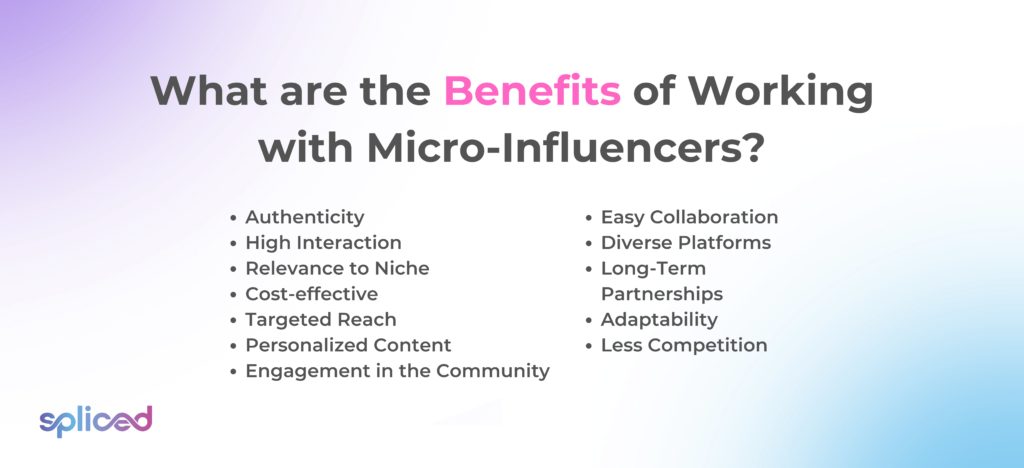
What are the Benefits of Working with Micro-Influencers?
Listed below are the benefits of working with Micro-influencers.
- Authenticity: Most micro-influencers have close, honest relationships with the people who follow them. The endorsements seem more real and trustworthy, which makes them more engaging and gives them more authority.
- High interaction: Compared to macro-influencers or celebrities, micro-influencers tend to have a higher interaction rate. They have more personal interactions and deeper relationships because they have fewer followers.
- Relevance to Niche: Most micro-influencers are experts in certain niches or businesses. The message reaches people who are interested in the goods or services by teaming up with influencers who are important to the brand.
- Cost-effective: Working with micro-influencers is cheaper than working with bigger influencers. Micro-influencers have lower fees or are willing to work for free, which makes them a good choice for smaller funds.
- Targeted Reach: Micro-influencers get fans who are interested in the same things as them. Micro-influencers’ targeted reach makes sure that the brand’s message gets to the right people, which leads to a higher rate of sales.
- Personalized content: Micro-influencers often make content that is tailored to their audience and gets a good response. The material is more personal and relevant, which makes people more interested in it.
- Engagement in the community: Micro-influencers have tight-knit groups where their followers are involved. Brands use these groups to get people interested in and loyal to them.
- Easy collaboration: Micro-influencers work with brands in a more personal way because they have fewer followers. Most communication is more clear and easy to handle, which makes working together easier.
- Diverse Platforms: Micro-influencers are active on a number of social media sites, so brands use influencer marketing on a number of different channels.
- Long-Term Partnerships: Getting to know micro-influencers lead to partnerships that last for a long time and give the business constant exposure.
- Adaptability: Micro-influencers are open to creative partnerships and change their content to match the message and values of the business.
- Less Competition: There is less competition for the attention of micro-influencers than there is for the attention of bigger influencers. It is easy to make connections and stand out.
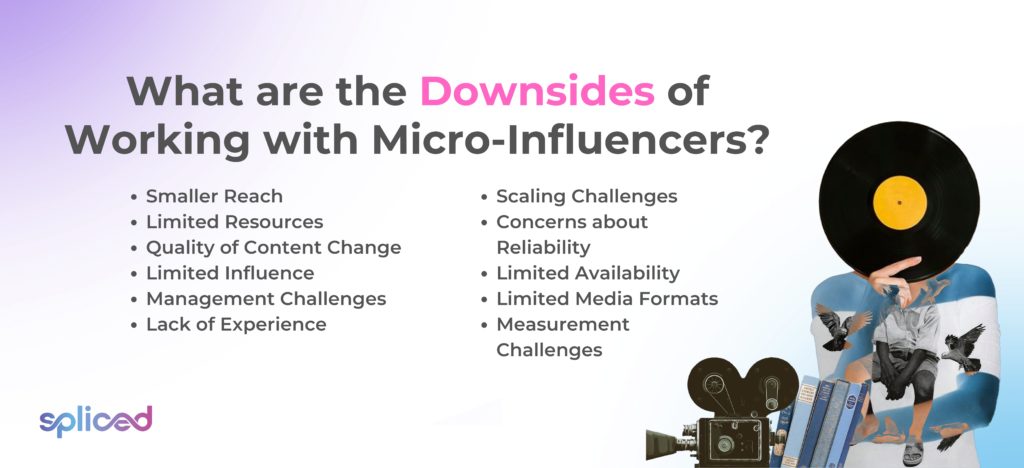
What are the Downsides of Working with Micro-Influencers?
Listed below are the downsides of working with Micro-influencers.
- Smaller Reach: Micro-influencers have fewer people who follow them compared to big influencers or celebrities. It means that even if people are more interested, the general reach is smaller.
- Limited Resources: Micro-influencers do not have as much money or time as bigger influencers or companies, and they do not always meet the same professional standards.
- Quality of Content Change: The quality of the content that micro-influencers make changes a lot. Some are not as good at making content as others, which leads to visuals and messages that do not match up.
- Limited Influence: Micro-influencers have a lot of power in their area, but their effect does not go beyond that. It needs to work with more than one micro-influencer if a brand wants to reach more people.
- Management Challenges: Managing a bigger number of micro-influencers takes more time than managing a single macro-influencer.
- Lack of Experience: Micro-influencers do not have much experience with brand collaborations, contract negotiations, and campaign standards, which leads to misunderstandings or goals that do not match up.
- Scaling Challenges: Only working with micro-influencers takes more work and coordination to get the same results as working with macro-influencers if a brand’s promotion needs to reach a lot of people.
- Concerns about Reliability: Some micro-influencers are not as reliable when it comes to meeting deadlines or sticking to content standards, which affects how the campaign is run.
- Limited Availability: It is hard to schedule posts and campaign activities around their schedules because micro-influencers often have day jobs or other responsibilities.
- Limited Media Formats: Micro-influencers only focus on certain types of content forms, which do not fit with the brand’s favorite media types.
- Measurement Challenges: It is hard to keep track of and measure the success of campaigns with multiple micro-influencers because their material and followers are so different.
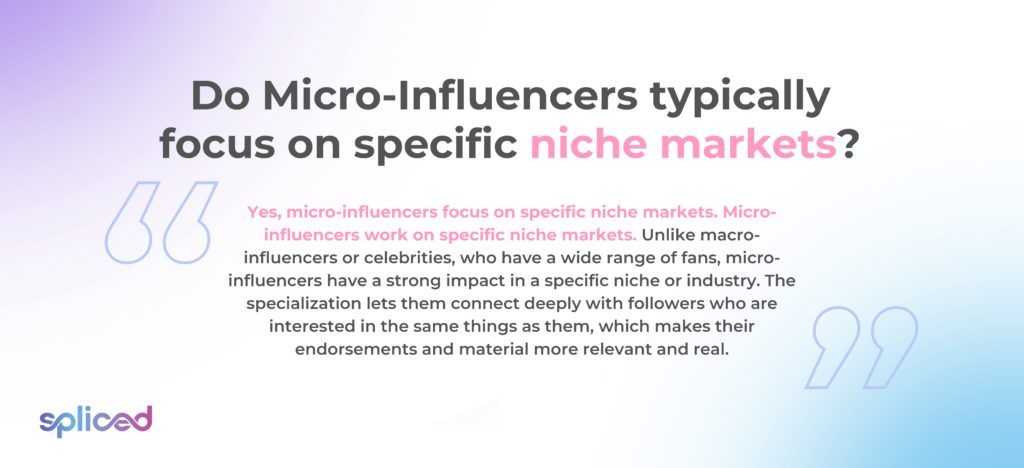
Do Micro-Influencers typically focus on specific niche markets?
Yes, micro-influencers focus on specific niche markets. Micro-influencers work on specific niche markets. Unlike macro-influencers or celebrities, who have a wide range of fans, micro-influencers have a strong impact in a specific niche or industry. The specialization lets them connect deeply with followers who are interested in the same things as them, which makes their endorsements and material more relevant and real.
Brands that want to reach specific groups genuinely benefit from working with them because micro-influencers are experts in their chosen niche. The focused content fits with what their followers are interested in, which makes their niche group more engaged and gives them more credibility.
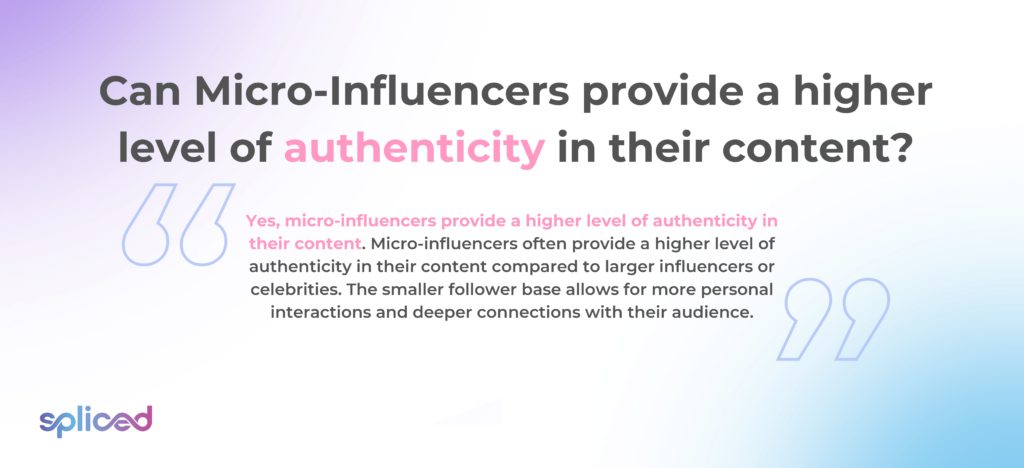
Can Micro-Influencers provide a higher level of authenticity in their content?
Yes, micro-influencers provide a higher level of authenticity in their content. Micro-influencers often provide a higher level of authenticity in their content compared to larger influencers or celebrities. The smaller follower base allows for more personal interactions and deeper connections with their audience.
Micro-influencers are individuals who are genuinely passionate about their niche, and their content reflects their personal experiences and opinions. The authenticity resonates with their followers, as they perceive the influencer’s recommendations and endorsements as more genuine and trustworthy.
Micro-influencers are more likely to engage directly with their audience, responding to comments and messages, which further enhances the authenticity of their online presence. Authenticity is a key factor in driving engagement, building trust, and fostering lasting relationships with their followers
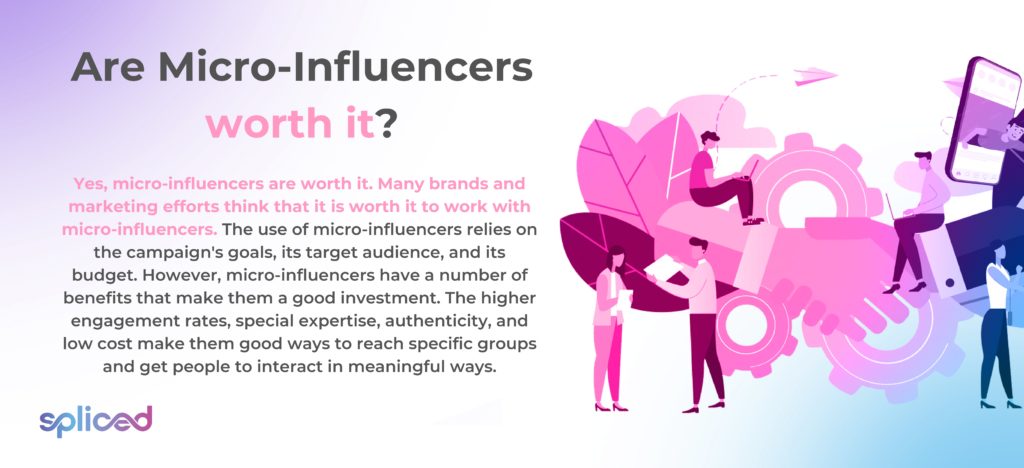
Are Micro-Influencers worth it?
Yes, micro-influencers are worth it. Many brands and marketing efforts think that it is worth it to work with micro-influencers. The use of micro-influencers relies on the campaign’s goals, its target audience, and its budget. However, micro-influencers have a number of benefits that make them a good investment. The higher engagement rates, special expertise, authenticity, and low cost make them good ways to reach specific groups and get people to interact in meaningful ways. Micro-influencers give brands targeted visibility, endorsements that people trust, and a personal touch that their followers like. It is important to choose the right micro-influencers, set clear goals, and set up good communication to get the most out of these partnerships.
What is the difference between Micro-Influencers and Nano Influencers?
Micro-influencers and nano-influencers represent distinct segments within influencer marketing, each offering unique characteristics that cater to specific campaign goals. Micro-influencers have follower counts ranging from 10,000 to 50,000, enjoying higher engagement rates due to their specialized audience.
The niche of expertise allows them to deliver tailored content, and their authenticity resonates well with followers. Collaborating with micro-influencers is often cost-effective, making it an appealing option for targeted campaigns. Nano influencers have even smaller follower counts, usually ranging from 1,000 to 10,000.
Nano influencers excel in engagement, maintaining strong personal connections with their audience despite their limited reach. They are known for their exceptional authenticity, focusing on hyper-local influence. The choice between them depends on the campaign’s scope, desired reach, and the level of personal connection brands aim to establish with their audience, while micro-influencers and nano-influencers are valuable.
